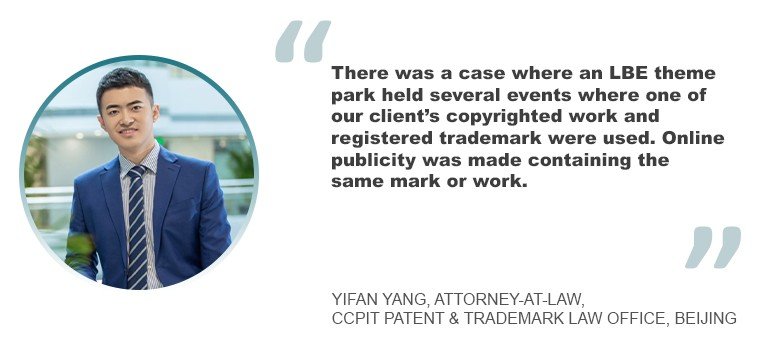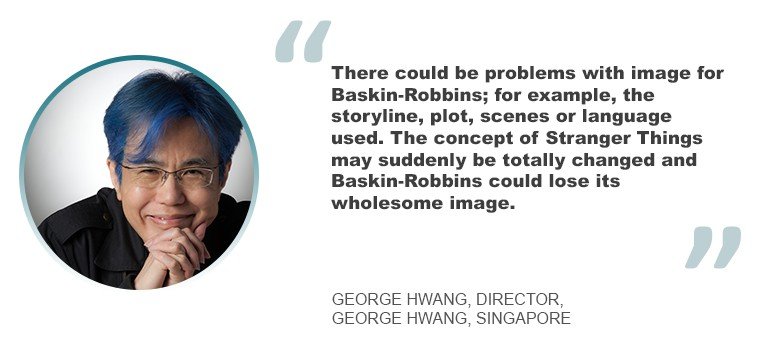The rise of location-based entertainment: IP and data privacy issues
30 November 2023

Location-based entertainment is growing in popularity, creating immersive and memorable experiences for consumers. Espie Angelica A. de Leon notes challenges with LBE and discusses the potential disputes that can arise when using copyrighted materials and branding in these entertainment venues.
In 2019, North American fans of the global hit Netflix series Stranger Things were swept up in Scoops Ahoy mania.
Scoops Ahoy, the fictional ice cream parlour featured in the sci-fi mystery drama, became a reality thanks to a partnership between Netflix and Baskin-Robbins to promote Season 3 of Stranger Things.
Under the collaboration, Scoops Ahoy was brought to life through a fleet of ice cream trucks that travelled across the U.S. West Coast. These trucks faithfully recreated the parlour’s nautical theme, with staff dressed in sailor uniforms, offering customers with a selection of Stranger Things-themed ice cream flavours and products, including the Demogorgon Sundae and the Elevenade Freeze.
Not stopping at just a mobile experience, pop-up Scoops Ahoy stores also emerged at Baskin-Robbins outlets in Burbank, Los Angeles and Toronto. These temporary transformations into Scoops Ahoy ice cream shops transported fans to the show’s 1985 setting, providing an immersive experience into an otherwise fictional world.
The Netflix-Baskin-Robbins partnership not only delighted fans but also showcased the growing trend of location-based entertainment (LBE), which has become a valuable tool for top brands for engaging customers and marketing. This type of entertainment combines different experiences such as dining, shopping, live entertainment and more in a single venue away from home.
These venues can take on many forms, from retail destinations and restaurants to arcades, exhibit areas, theme parks, escape rooms, movie theatres and outdoor spaces. The key feature of LBE is that activities within the venue often operate under a single theme, with themed characters joining in the fun and partner brand merchandise readily available for purchase.
For a more immersive experience, LBE operators also use virtual reality (VR) and augmented reality (AR) in their offerings.
Notable examples of LBE initiatives include the Wizarding World of Harry Potter in Orlando and the Immersive Gamebox platform. The latter taps on the global popularity of Squid Games and Angry Birds to deliver engaging group gaming activities through interactive digital smart rooms.
Location-based entertainment in Asia
Asia is no stranger to LBE, including immersive experiential destinations. The market for the industry is projected to grow from a valuation of US$1.44 billion in 2023 to US$2.92 billion by 2028.
In China, LBE is quite popular, and theme parks are common destinations beyond malls and experiential retail outlets. One of these is Millennium City Park in Kaifeng, Henan province; the park is a real scene construction of Along the River During the Qingming Festival, a painting from the Song Dynasty and a national treasure. The painting vividly depicts the urban scene of China’s capital in the 12th century.

“In recent years, fairs in urban areas with various themes – coffee, books, vintage, handicrafts or a combination of those – have become another emerging trend of LBE in big cities,” shared Chun Du, a trademark attorney at CCPIT Patent & Trademark Law Office in Beijing. “Based on the number of business participants, the intellectual property components involved in such fairs could be quite plentiful.”
LBE is also gaining traction in India, particularly in the AR/VR sector. One of the most popular is The Void, which offers a global VR experience based on popular franchises such as Star Wars and Ghostbusters. Another emerging trend is VRcade, a virtual reality gaming arcades offering a wide range of VR experiences, from action-packed games to educational simulations.
In Singapore, LBE has existed for a long time, with venues ranging from amusement parks, theme parks, arcades and cineplexes.
Meanwhile, South Korea infuses its LBE destinations with elements of K-drama and K-pop.
The intricacies of IP in the LBE industry

“The realm of IP within the LBE industry is a dynamic landscape where traditional concepts intersect with cutting-edge technologies,” said Harsha Aswani, an associate at Khurana & Khurana in Noida. “In other words, while the core legal paradigms surrounding IP rights, including licensing and content protection, are indeed consistent across various entertainment zones, what changes are the nuances and the ways in which these issues manifest in newer technologies and experiences.”
Aswani, who has worked with clients in the LBE industry, including various brands, IP owners, LBE operators and content creators, and software developers for AR/VR technology, emphasized that IP in immersive LBE experiences involves a wide range of elements. Traditional copyright concerns, for instance, extend to encompass 3D models, augmented content and the intricate design of virtual environments. This differs from copyright in traditional cinema, which primarily focuses on films and distribution.
According to Aswani, it is the same with licensing. “Licensing, a cornerstone of the LBE world, transcends the physical branding and merchandising in a theme park into virtual product placements within a digital environment curated by AR/VR technology. This shift necessitates a profound understanding of the ‘digitally native’ licensing paradigm, where space and form become fluid, and agreements must adapt accordingly,” she explained.
Potential disputes in the LBE industry, particularly the LBE AR/VR sector, take various forms, including contractual breachesrelated to IP licensing and development or partnership agreements.
LBE operators may unintentionally incorporate copyrighted materials or content, iconic characters of popular brands, designs, proprietary technology and the like without proper licensing. This may lead to the following:
- copyright infringement claims from original content owners;
- character right and trademark infringement claims from the brand owners;
- patent infringement claims for breach of software patents, if any, or the proprietary technology of another;
- trade secret infringement or misappropriation; and
- design infringement, etc.

“This highlights the imperative to seek clarity amidst the digital mirage,” noted Aswani.
Yifan Yang, an attorney-at-law at CCPIT Patent & Trademark Law Office in Beijing, related a case that firm handled: “There was a case where an LBE theme park held several events where one of our client’s copyrighted work and registered trademark were used. Online publicity was made containing the same mark or work. We sent warning letters to the theme park on behalf of our client, and they stopped the infringing use and deleted the related online postings.”

“What could be more difficult will be things which are not registrable as trademarks, such as the get-up of the cafes,” added George Hwang, director of George Hwang in Singapore, referring to the 2019 Netflix-Baskin-Robbins partnership. “There could also be problems with image for Baskin-Robbins, for example, the storyline, plot, scenes or language used. The concept of Stranger Things may suddenly be changed and Baskin-Robbins could lose its wholesome image.”
There is also the risk of piracy and claims of unauthorized distribution, where individuals or entities may attempt to copy and distribute the LBE AR/VR content without permission.
Ownership disputes are another are of concern, particularly when multipleparties are involved in an LBE project. Aswani stressed the importance of defining ownership, as disputes over the right to use and monetize IP can become highly complex and emerge as challenges.
Also, things could get a little tricky in marketing where joint ventures are involved, especially if the LBE project is going to be a new business for one of the parties.
Going back to the Netflix-Baskin-Robbins partnership, Hwang explained: “Netflix is not in the business of F&B. It started as a tech company which streams films and is now a producer as well. It should be aware that it is not only endorsing Baskin Robbins but could be creating goodwill in the business of cafes when using this marketing tool. Baskin-Robbins will have its brand, image and technology or know-how in F&B management to protect, while Netflix will be the image of Stranger Things. If Scoops Ahoy is supposed to serve excellent ice cream and food, then lousy food could erode its image and fan base.”
According to Aswani, brands engaging in or partnering with other brands for an LBE initiative must take a multi-faceted approach to protect their IP. This approach should include the following:
A comprehensive contractual framework. Crafting precise contractual agreements after a comprehensive due diligence process is especially important in the LBE industry, as immersive experiential activities thrive on collaboration between multiple players.
“Details of licensed use of IP related materials – which may involve logos, brand names, images, various kinds of audio-visual materials, the technical equipment that carry such materials, among others – should be confirmed and fixed by valid commercial agreements. And this also applies to the business cooperation between the IP owner and the organizer or operator of the LBE,” said Du.
“These agreements should outline the scope of IP usage, ownership rights, licensing terms, territory, exclusivity and dispute-resolution mechanisms. When sharing sensitive information with partners or collaborators, use NDAs to safeguard confidential IP. This prevents unauthorized use or disclosure. If licensing IP to another party, specify the scope, duration, limitations of the license and enforcement mechanisms for violations,” added Aswani.
Aswani related her team’s experience with an AR/VR startup specializing in interactive gaming experiences. The startup aimed to secure licensing agreements with major entertainment franchises and enabled them to use the latter’s characters and content within the startup’s immersive games.
“We were tasked with creating meticulous licensing agreements that would grant the startup the necessary rights to use the characters and content while ensuring the protection and integrity of the IP owners’ assets,” she said. This involved extensive market research to gain insights into the competitive landscape, allowing them to tailor their strategy to the unique challenges and opportunities of the AR/VR gaming industry.
The strategic understanding gained through this research played a pivotal role in structuring agreements that aligned with the client’s objectives and ensured compliance with the ever-evolving legal framework governing AR/VR. Risk mitigation strategies, including indemnification clauses and dispute resolution mechanisms, were also incorporated within the licensing agreements.
Periodic IP audits. Review existing IP portfolios, identify potential gaps and ensure that all IP assets are adequately protected.
Vigilant compliance monitoring. Track the use of licensed content. Make sure you are adhering to branding guidelines and that all parties involved are upholding their IP-related commitments.
Digital safeguards.“In the digital age, safeguarding digital assets is crucial. Implementing robust cybersecurity measures to protect against IP theft and data breaches is imperative. The digital realm can be both a playground and a battlefield for IP, and it is essential to fortify the defenses,” said Aswani.
Proactive IP management. Aswani emphasized the importance of a proactive approach, rather than a reactive one, in managing IP assets. “This involves developing a long-term IP strategy that aligns with the evolving needs of the LBE industry. It is about staying ahead of the curve, anticipating challenges and leveraging IP for strategic advantage,” she explained. Long-term IP strategy should also consider the brand’s future expansion and IP portfolio management.
Implement security and technological measures.Among these measures are encryption, digital rights management and watermarking. These are effective in preventing piracy, unauthorized copying and distribution of LBE, particularly AR/VR content.
IP insurance. Businesses shouldconsider IP insurance to mitigate financial risks associated with IP disputes or infringement claims.
Employee and partner training on IP rights and IP protection.
Legal expertise.
Data privacy issues
In the expanding LBE AR/VR industry, data privacy should not be overlooked.
“While traditional entertainment settings primarily protect user data related to ticket sales, email addresses and contact numbers, the LBE AR/VR environment presents a paradigm shift. Here, ‘user data’ extends far beyond the conventional scope and encompasses sensitive and highly personal information,” explained Aswani.
User data in the LBE AR/VR sector also includes biometric data such as facial recognition, hand gestures, heart rate, body movements and other physiological indicators; these help enhance the immersive experience. It also involves data generated by gaze tracking, allowing AR/VR systems to monitor where users are looking within a virtual environment, as well as user behavior analysis, which contains data on how users interact with the virtual environment, make choices and react.
To address data privacy concerns, Aswani encourages stakeholders in the LBE AR/VR industry to implement the following policies and practices, among others:
- There should be informed consent.Users should be informed about the types of data collected and how these data will be used. They should also have the option to consent or opt-out.
- Data encryption. Robust encryption measures must be in place to safeguard the storage and transmission of sensitive data.
- Data minimization. Only necessary data must be collected. Avoid unnecessary or excessive data collection.
- Data anonymization. Strip data of personally identifiable information to protect user identities.
- Regular audits and assessments.The objective is to ensure compliance with privacy regulations and industry best practices.
- Transparent policies. It is important to be transparent about data handling practices through clear and accessible privacy policies.
“As the LBE AR/VR industry continues to expand, a proactive and ethical approach to data privacy is paramount. Striking a balance between providing immersive experiences and safeguarding user data will be crucial to building trust and ensuring the long-term success of this exciting entertainment frontier,” said Aswani.






